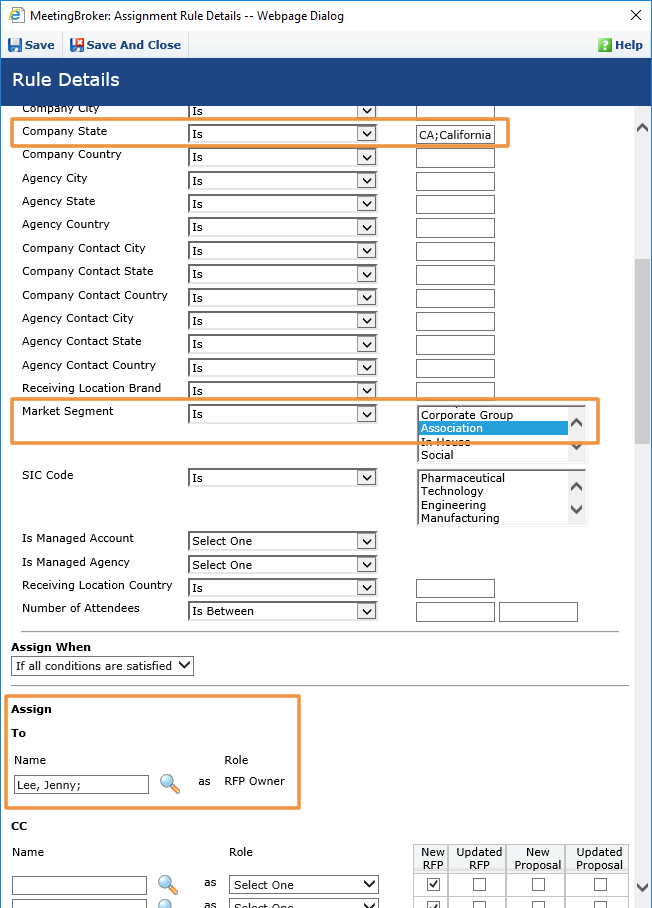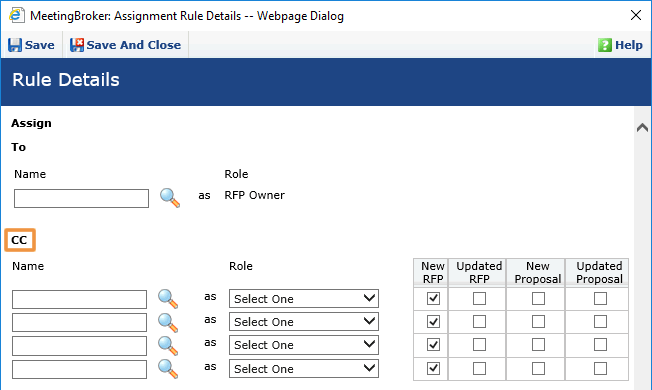Overview: Assignment rules
Assignment rules allow you to accomplish certain actions with your incoming RFPs:
- Automatically assign an RFP Owner
- Copy other users who should have access to help the owner
- Apply an escalation policy to ensure a timely response to the customer
You can choose to do any number of these actions with the rules you create.
Assignment rules do not apply to email only locations.
The RFP Owner is typically the person who gets credit for the booking in reports and is the main contact for the customer when negotiating a contract. Owner assignment is managed at the location level and is handled in one of two ways:
- Assignment rules are not created, sending all new RFPs to the location's Default Lead Coordinator (DLC) who reviews each one and then reassigns to the appropriate Sales Manager. The DLC is assigned on the Location Details page.
- Create location assignment rules to automatically assign to the appropriate sales manager when possible. RFPs that don't match any rules go to the DLC.
For example, at The City Hotel, Jenny Lee is responsible for all association business from California. You can create an assignment rule that automatically assigns Jenny as the RFP Owner by comparing the Market Segment and the Company State fields for a match.
Assignment rules are dependent upon the information provided by the sender and the channel. Think about how you distribute leads to your team and consider the following to determine if assignment rules are a good fit for your property.
Assignment rules are recommended if you distribute leads by:
- Geography (account or agency state/zip/country)
- Peak Guestroom Count
- Channel (for example: one person handles all Cvent leads)
- Company name (for example: one person handles all LRB Communications leads)
However, if you distribute leads by Market Segment or SIC Code, the channels you subscribe to can determine whether or not you should use assignment rules. For example, Cvent doesn't have fields for Market Segment or SIC Code, so if your team is organized by market segment and the only channel at your location is Cvent, you would not use assignment rules.
For A Location
When creating location assignment rules, you can copy other people on new RFPs that match the rule.
Copying a user adds them to the RFP Team, which gives them access to open and edit the RFP. If the owner has an assistant or a partner who helps them respond to leads when they are busy, you can copy them. Or if you want to copy the DLC on all leads that are automatically assigned so they can monitor for duplicate leads, that's an option too.
For The Subscription
Even though they are called assignment rules, the rules created on the subscription level do not actually assign anything. Instead, they copy users when conditions are met at any of the locations in the subscription. Create an assignment rule on the subscription level when you want to alert team members about company-wide activity.
For example, Lara Jackson is the Global Sales Manager for The National Association of Jewelers account. Every property is required to copy her when a lead is received for this key account. Instead of creating a location-level rule for each property, you can create one rule on the subscription level that applies to all properties.
You have an option with subscription rules to either apply all rules that match, or apply the first rule that matches. Learn all about this option and how to use it in the Manage subscription assignment rules topic.
At the bottom of each Assignment Rule Details page, you have the option to apply escalation.
If certain steps haven't been completed for the RFP after a specified amount of time, you can send email reminders to the RFP Owner and other users to make sure the customer doesn't wait too long for a response. For example, if a proposal hasn't been sent two hours after the lead was received, escalation can email the RFP Owner and copy the DLC.
There are many different ways to configure escalation. See Overview: Escalation for more information.
If you are a location administrator, check with your subscription administrator for your company's escalation standards before you use this feature.
Subscription and location rules working together
An incoming RFP can match both a location assignment rule and multiple subscription assignment rules. In this case, Assignment and cc from both types of rules will be applied. However, this is not true for escalations.
For example, a new RFP is received by The City Hotel for The National Association of Jewelers and the office is based in California. MeetingBroker compares the RFP with all the subscription rules and the location rules for The City Hotel.
- There is a subscription rule that copies Lara Jackson on RFPs from The National Association of Jewelers.
- There is a location rule that assigns Jenny Lee as the RFP Owner for association leads that come from California.
Both of these are a match, so Jenny is assigned as the RFP Owner by the location assignment rule because of the Market Segment and Company State, and Lara Jackson is copied on the RFP by the subscription assignment rule because of the Company Name.
However, if escalation was applied to both the subscription and location rules, only the subscription escalation policy would be used. The location policy would be ignored. For this reason, it is important for subscription and location administrators to understand their company's plan for using escalation. Typically, a decision is made for escalation to always be applied in one place or the other (always subscription or always location) to ensure there are no conflicts. See Overview: Escalation for full details.
Learn more...
Manage subscription assignment rules


